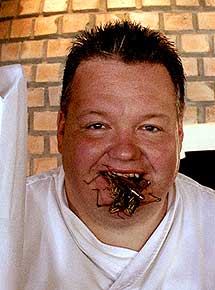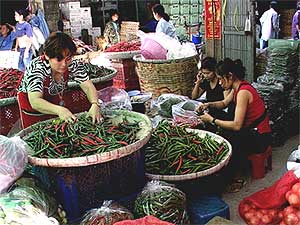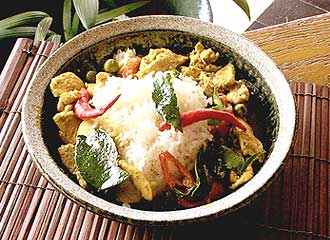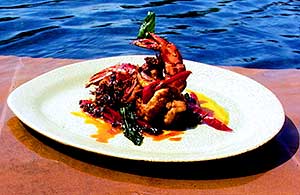|
|
I Can’t Believe I Ate the Whole Bug!
|
I recently visited Thailand at what was universally–though smilingly–acknowledged to be “the worst time of year.” That would be spring, with temps sizzling up several hundred degrees F. and the humidity slightly less than being submerged. Despite the climate, the Thai people, Thai food and Thailand itself were all great.
The only thing hotter than the weather was the food. Thai cooking is a blend of the diverse cuisines of the people who became Thai, principally Chinese and East Indian. There’s a physio-spiritual undertone to the cooking which seeks to engage all the taste sensations: salty, sour, sweet, and spicy hot. The most frequent and distinctively used spices are: lemon grass, garlic, shallots, basils (both the sweet and the peppery holy basil), limes (particularly the near-dry kaffir lime which you may have to seek out in an Asian market), ginger (including galangal and “blue”), and chile peppers of all types. Chiles, which are now so ingrained in contemporary Thai cooking, are a fairly late introduction, having been brought in by Portuguese explorers and traders during the 16th century. But the Thais quickly made it their own and now have many home-grown varieties (including the tiny but fiery prik kee nu, or “mouse turd” pepper).
|
|
A variety of colors, shapes, and
|
Food-wise, things get hotter the farther north you go. I took the current ad slogan “Amazing Thailand” as a personal challenge and decided to amaze the Thais by requesting more chile after repeated warnings of “too hot for the farangs (foreigners).”As in most developed exotic climes, major hotels and tourist restaurants tended to downplay the spicy nature of local cuisine so much that the dishes served were bland. But the omnipresent noodles were always quickly cooked to order and, thankfully, locals and farang alike can spice to taste. Chile was available at every meal in several forms: red flake, thinly slivered in vinegar or fish sauce, as a paste and–I might be mistaken about this–injectable.
City of Traffic
My tour of Thailand began in Bangkok and one of the first things I noticed is that there’s a golf course in the middle of the airport! A bad slice from the seventh green could take bring down Air India flight 687. Bangkok is one of the Southeast Asia’s major shopping centers. It differs from Hong Kong yet has a similar dizzying price spread from world-class designer items with heavy taxes (400% on alcohol!) to incredible bargains. I really scored with a genuine Rolodex watch for only US $4.23! And, it’s still working. No, wait a second. Damn. And, of course, markets and food emporia are everywhere. You can’t help but notice the incredible array of tropical fruits, many of which look like props from “Star Trek” and a few that smell like garbage scow bilge and hospital disinfectant–with a hint of mint.
|
|
Ready-made chile pastes at a local market.
|
Bangkok is in the center of Thailand and is not dominated by the fresh, varied seafood so plentiful in the south nor by the frequently challenging ethnic exotica of the north and east (with their Burmese, Laotian and hill tribe influences). It does have dipping sauces and some spicy ones at that. Rice rules, meats and even vegetables are use sparsely, and the condiments themselves are afterthoughts. Ubiquitous sweet chili sauce is a staple here as throughout Asian centers from Viet Nam to east L.A. I never did figure out why they all sport a rooster on their label. There’s no rooster in the sauces.
Big citiness means that Bangkok has both the bad (traffic, pollution, Britney Spears billboards) and the good (fast tailoring that has eclipsed Hong Kong’s, accessible English, and every conceivable kind of restaurant). Corporate fast food giants are present but are sampled as sparingly as most Thais prefer their indigenous and, more often than not, homemade dishes. And many folk snack on the endless varieties of street food. (I did not, since I was unsure just how long omelet ingredients and raw poultry had been exposed to sun.) I’ll confess to tourist culinary cowardice, in opting for a hotel buffet breakfast. These are usually good deals, giving wide choices at uncustomarily low prices. They also feature both Western and Asian dishes (Chinese dim sum, Japanese soups, and Thai noodles). I also encountered dragon fruit, an import from Vietnam. It’s gorgeous; a purplish-red skin with green scale-like protrusions. The interior is startlingly white and dotted with tiny, edible black seeds. Unfortunately, for all its visual enticement, the thing has no discernible flavor. I know this because I kept resampling it at various venues during my entire stay.
Bugs in the North
For flavor and variety, whether in food or culture, Chiang Mai is the place. It’s also the capital of the north (and the country’s second largest city), boasting history, far less Westernization than Bangkok, and country folk from the Thai heartland. In recent years, this region has been invaded by foreign visitors seeking authentic, non-touristy experiences and, as a result, there are a half-dozen tony resorts and several times that number of attractions, most of which concern animals (elephant treks, cobra shows and the like). We stayed at the Regent, regarded as not only the top resort in Chiang Mai, but as one of the ten best in the world. In addition to a full spa and resort activities, and in lieu of a centerpiece golf course, they have a small working rice paddy and a family of water buffalo on site. There are also butterfly farms in the area, but the insects are not merely for viewing. I went to a local market to sample real regional delicacies: bamboo and silk worms, crickets, and some larvae to which I was never formally introduced. They were crunchy, salty and slightly greasy–perfect with Singha beer and a sports event that I also probably never sampled before either. The bugs could’ve used some chile though.
Near Chiang Mai is Chiang Rai and the infamous “Golden Triangle,” on the Mekong river at the confluence of Thailand, Myanmar (Burma) and Laos. The border areas are still hotbeds of smuggling, drugs, militancy, and recent lethal border skirmishes between Thai Army regulars and Burmese drug-lord insurgents. I watched a Thai border guard eat a lunch of fried fish, rice, and two styles of chile: sweet sauce and powder. The opposing Burmese Army was stationed too far away for me to see what was on their menu.
I visited the beautiful Mae Sa Valley and one of the first resorts in the area, one still loaded with rustic charm. A natural river courses its way through the jungley grounds, an assortment of native arts are taught at the crafts village, and I had my first formal lesson in Thai cooking.
The chef, Npgjk (real name!), doesn’t so much teach as “do her thing” and challenge you to keep up and absorb what you can. An American couple also tried and was so successful they wound up making what became their dinner that evening. I, on the other hand, unintentionally blackened Pork Toasts (Kanom Bang Na Moo) that I hadn’t crafted too well to begin with and followed that up with a way too greasy Green Beef Curry (Gaeng Kiow Wan) that couldn’t be saved by even the accompanying sticky rice so prevalent in the north. I rebounded with Wok Fried Pork and Ginger (Moo Pad King) but still chose to order off the menu that evening.
Insects in the South
Vietnam-era soldiers discovered the then-unspoiled pleasure paradises of Thailand in two areas: Pattaya and Phuket. How overdeveloped these beaches are depends on either your tolerance or unbridled libido. Phuket still has great beaches but Patong is an absolute sensory assault of bars, restaurants, hotels, and adult diversions. To recapture –and maintain—the original, and now largely lost, pristine beauty of the place, a brand new Marriott resort just opened 40 klicks up the coast at a beach formally known solely to breeding loggerhead turtles. The complex has adopted the critter as its logo and actively participates in preservation programs.
Here, I got my second lesson in Thai cooking from their executive chef Anthony Tuttle. He’s immersed himself in Thai culture and has surrounded himself with a dedicated and talented staff of cooks –including some gifted locals. Right now the lessons are held in one of the restaurants but plans are already in the works to move classes to a special and permanent teaching kitchen. Chef Tuttle not only takes advantage of the terrific spices but also of what else is available via the area’s geographic location.
|
|
More typical of what Chef Tony
|
Phuket is an island surrounded by seafood. Delicious seafood. Many of them are unique, such as the local rock lobster, but few are as tasty as the large prawns. The chef prepared them in simple, fast, wok flash-fried dish called Phad Khi Mao Kung. Not content with this masterpiece, he went on to whip up Kaeng Khiao Wan Kai (Chicken Green Curry) and Som Tom (a green papaya salad which, although a popular Thai specialty, is not often found on U.S. restaurant menus). Satisfied, he thought he was done. But he hadn’t reckoned with a crazy food writer who’d actually read his resumé, noted that he’d worked in Mexico, and put that background together with the obscure ethnic specialties of Thailand. I’d prevailed upon his indigenous staff to bring in a sample supply of fresh Patung Kha (grasshopper), Ging Reed (cricket), Nohn Mai Phai (bamboo worm), and the “falling bug” Mang Phup, a two-inch long cockroach-like thing that flies so poorly, it may be the world’s only self-swatting insect.
|
|
The prawns nearly jumped
|
Slightly green around the gills–but still game–Tuttle took up the challenge. We asked how the natives do it. Basically, the preparation is the same for all crawlies: deep fry the hell out of ‘em until crunchy, slather with Maggi sauce and a generous shake of salt, masticate while washing the bugs down with lots of beer. Piece o’ cake! You could savor a styrofoam cup that way. We selected, we cooked (this time adding chile), and we tasted. All in all, the bugs were not bad; in fact, I liked the bamboo worms, which some refer to as “jungle French fries.” While his kitchen staff happily chowed down, Chef Tuttle stood cautiously off to one side, watching at a safe distance, and smiling unsurely. We descended on him en mass and “force-fed” him. While not Tuttle’s favorite meal, the accompanying photo is proof to his kids that either (a) Daddy’s got guts, or (b) Daddy is nuts. Reflecting on rapidly-changing, ethnically-influenced food trends, Tuttle expressed doubt that bugs would soon be on the Marriott menu. However the bamboo worms were available in cans at the airport!
Resources
Taiwan’s EVA airlines has great deals on round-trips to Bangkok. They have 4 classes (for $200 over economy fare, you have business class comfort). 1-800-695-1188 or www.evaair.com
Websites:www.tourismthailand.org
Chiang Mai Regent Resort: www.fourseasons.com or 1-800 545-4000
Bangkok Marriott Resort and Spa and new Marriott Phuket: www.Marriott.com and www.marriotthotels.com
Mae Sa Valley Resort and craft village:
http://www.thailandhotels.net/chiangmai.htm or 053-290-051-2
Recipes
As this is always a homemade concoction, recipes vary for both ingredients and amounts. The rule-of-thumb is “to taste.” A key element that all agree on is the difficult-to-make roasted, powdered rice which I‘ve yet to find on U.S. market shelves. To make it, sauté rice in lime juice until browned but still with a trace of moisture then grind into a medium powder. This condiment is used to spice up any dish. Try it over rice pilaf.
-
1 ½ tablespoons ground, roasted rice
-
1 ½ tablespoons chile powder
-
1 tablespoon lemon juice
-
1 tablespoon tamarind sauce
-
½ tablespoon sugar (palm sugar is best)
-
1 shallot, peeled and sliced
-
1 tablespoon soy sauce
-
2 tablespoons fish sauce
-
2 cloves garlic, chopped
-
1 cilantro root, minced (optional)
-
1/4 cup water or more if needed
In a bowl, combine all ingredients and mix thoroughly. Transfer to a blender and puree. Return the
sauce to the bowl and place it in the regfrigerator for at least 3 hourse for the flavors to blend
and the rice to soften. Garnish with minced parsley, mint, and spring onion.
Yield: 1/2 cup
Heat Scale: Hot
Kaow Soy Kai (Curry Noodle Soup with Chicken)
This is a favorite soup at The Regent Resort Chiang Mai. It is well worth the effort to prepare it.
-
1/3 cup vegetable oil
-
1 ½ tablespoons red curry paste
-
½ teaspoon cumin powder
-
4 cups coconut milk
-
1/4 cup fish sauce
-
1 ½ tablespoons curry powder
-
1 pound chicken meat, cubed
-
14 ounces yellow vermicelli (Chinese egg noodles)
-
Vegetable oil for deep frying
-
For garnish: pickled Chinese cabbage, lime slices, and sliced shallots
In a wok, combine the vegetable oil, red curry paste, cumin, coconut milk, fish sauce, and curry powder and bring to a boil. Add the chicken, reduce the heat, and cook for 10 minutes. While the chicken is cooking, boil half of the vermicelli in a pot for 3 minutes, remove and plunge into ice water, and transfer to the wok. Deep-fry the other half of the vermicelli but do not brown. They should be yellow and crispy. Remove from the oil and drain on paper towels. To assemble, transfer the chicken mixture to bowls and add the fried vermicelli over the top. Garnish with the cabbage, lime slices, and shallots.
Yield: 4 servings
Heat Scale: Medium
This simple salad is amazingly delicious. It is difficult to find green papayas, so you will have to search Asian markets for it. You can make the dressing in a food processor as long as you do not pulse it too fine.
-
1 clove garlic, minced
-
1 small red chile, seeds and stem removed, minced.
-
1/4 cup roasted peanuts
-
1/4 cup small dried shrimp (available in Asian markets)
-
1 tablespoon fish sauce
-
1 tablespoon lemon juice
-
1 teaspoon palm sugar
-
1 green papaya, peeled, seeds removed, julienned
-
2 ounces green beans, cut into ½-inch pieces
-
1 medium tomato, chopped
In a wooden mortar or pestle, crush together the garlic, chile, peanuts and shrimp. Add the fish sauce, lemon juice, and sugar and mix well. In a bowl, combine the papaya, beans and tomato and mix well. Add the dressing from the mortar and toss.
Yield: 6 servings
Heat Scale: Mild
Moo Pad King (Pork Fried with Ginger)
This recipe, from the Mae Sa Valley Resort Cooking School, can be made with chicken or beef. Serve it with sticky rice.
-
2 tablespoons vegetable oil
-
2 garlic cloves, finely chopped
-
2 ounces boneless pork, finely sliced
-
6 pieces dried mushroom, soaked in water for 10 minutes to soften, then coarsely chopped
-
2-inch piece ginger, peel and finely sliced
-
1 teaspoon light soy sauce
-
1 teaspoon dark soy sauce
-
1 teaspoon sugar
-
2 tablespoons beef stock
-
½ teaspoon fish sauce
-
½ small onion, finely sliced
-
1 red chile, seeds and stems removed, finely sliced
-
1 spring onion (green part only, cut into 1-inch pieces
-
Ground white pepper
In a wok or frying pan, heat the oil until hot. Add the garlic and fry until golden brown. Add the pork, stir and cook for a minute or two until the meat is opaque. Add the mushrooms and ginger and stir thoroughly. Stirring briskly after each addition, add the soy sauces, sugar, stock, fish sauce, onion, and chile. Cook for 30 seconds, transfer to a serving dish, garnish with the spring onion pieces and sprinkle lightly with ground white pepper.
Yield: 2 servings
Heat Scale: Medium
Kaeng Khiao Wan Kai (Green Chicken Curry)
This recipe is courtesy of the Marriott Phuket Resort and Spa. Serve it with rice and Green Papaya Salad, above.
-
4 chicken legs
-
2 tablespoon vegetable oil
-
3 tablespoons green chile paste
-
1 cup coconut cream
-
2 kaffir lime leaves (available in Asian markets)
-
1 ½ cups coconut milk
-
1 tablespoon sugar
-
1 ½ teaspoons fish sauce
-
½ cup diced eggplant
-
1/4 cup chopped basil
-
1 red chile, julienned
In a pan, fry the chicken legs in 1 tablespoon oil until done. Remove from the heat. In a separate pan, fry the chile paste in the remaining oil until fragrant, stirring constantly. Add the coconut cream a little at a time and cook until the cream begins to have an oily sheen. Place the chicken and lime leaves in the cream and cook for two minutes. Add the coconut milk, sugar, and fish sauce, and eggplant, and bring to a boil. Boil for 1 minute, remove from the heat and add the basil. Garnish with the julienned chile.
Yield: 4 servings
Heat Scale: Medium
Phad Khi Mao Kung (Spicy Stir-Fried Prawns)
This is the method used by chef Anthony Tuttle at the Marriott Phuket Resort and Spa’s cooking school to prepare those delicious prawns. Serve the prawns with jasmine rice.
The Paste
-
6 fresh Thai bird chiles, or substitute piquins, seeds and stems removed, chopped
-
5 shallots, peeled and chopped
-
10 cloves garlic, chopped
-
½ teaspoon shrimp paste
The Prawns
-
3 tablespoons vegetable oil
-
12 large prawns, peeled and deveined, tail on
-
1 teaspoon sugar
-
2 tablespoons fish sauce
-
½ cup chopped holy basil
With a mortar and pestle, pound the paste ingredients together to form a paste. It does not have to be smooth. Place the oil in a wok, heat, and then add the paste and stir-fry until fragrant. Add the prawns and stir-fry until cooked, about 2 minutes. Add the sugar and fish sauce and stir. Remove from the heat and add the basil.
Yield: 4 servings
Heat Scale: Hot









